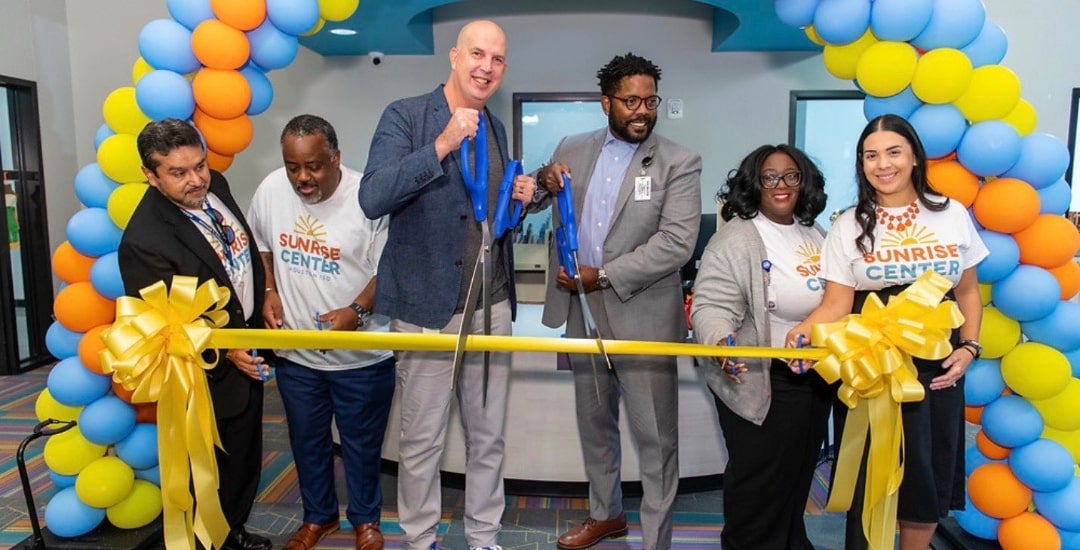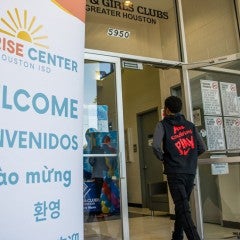In the fall of 2023, HISD established seven Sunrise Centers to serve as gateways to connect families and students to services that can help close those gaps. They are now the district’s primary source of noninstructional support.
“When I think about the immediate goal of Sunrise Centers, it’s an acknowledgement that some of our students come from hard circumstances,” said Najah Callander, the deputy chief of family and community partnerships at HISD. “Their families need a little bit of support to help them show up to school, ready to learn.”
Each center offers case management, clothing and uniforms, a food pantry, medical care, mental health care, and student and parent enrichment.
“From a longer-term perspective, it’s HISD showing its commitment to community,” Callander said. “Sunrise Centers are also an acknowledgement that we have a part to play in the overall health and well-being of families in our community.”
HISD’s nearly 15-year collaboration with the Kinder Institute’s Houston Education Research Consortium (HERC) has informed its approach to noninstructional services and supports.
When it came time to evaluate the program’s first year, HISD asked the Kinder Institute to identify what was working and what could be improved. The results of that effort, published last month, are already helping the district implement improvements, officials said.
Critical insights at a critical time
The findings,
That means Sunrise Centers serve as the primary hubs of noninstructional needs in a district where 80% of students are economically disadvantaged. They will be working in partnership with staff at HISD campuses to advance their mission.
“One purpose of this collaboration is to support continuous improvement of the system,” said Gabriela Sánchez-Soto, a senior researcher at the Kinder Institute. “The benefit of that is students are receiving the supports they greatly need.
“From the research side, the collaboration has been important because it enables us to tailor the work to the centers, and also to understand what’s happening on the ground, versus looking at numbers and making decisions.”
For example, researchers found that the seven current Sunrise Centers were within a 10-minute drive or 15-minute walk of several bus stops, putting them within reach of most students. However, researchers also found that 39% of campus staff were not aware of what was offered at the centers and 36% were unaware they existed.
Sunrise Centers are open year-round, Monday through Friday, typically from 8 a.m. to 5 p.m. Students may be referred to the centers by teachers or other campus staff, and all of the locations accept walk-ins.
Sunrise Centers differ from HISD’s wraparound services department by serving as “one-stop shops.” Previously, campuses could only address specific noninstructional needs; other assistance was accessed at service provider locations around the city.
In 2023-24, their first year of operation, Sunrise Centers served over 30,000 students. As the centers look to expand their partnership with campus-level staff, officials think they could see more students.
Meeting the needs
Among the greatest needs for students is access to mental health care, according to the Kinder Institute research. Students could receive a referral from wraparound services for mental health care, but Callander said the department was unable to confirm whether students had received help.
Sunrise Centers have addressed that problem.
“If a student is suffering from depression or anxiety, there is a mental health provider on site to connect them with. It’s not a waiting game,” Callander said. “We’re no longer simply counting the number of students we identify with mental health needs. We’re now counting the number of students who have received services or the number of hours of therapy they have received.”
In the Kinder Institute’s latest research, Sunrise Center staff members reported working closely with community members and organizations like Communities in Schools, the Houston Food Bank and the YMCA of Greater Houston, and touted the benefits of being embedded within a community. For example, one Sunrise Center is located within the West Orem Family YMCA.
“I do love the fact that we are in a community center,” said one staffer. “We’re not just a random building that’s dedicated to HISD Sunrise Center. I like the fact that we’re connecting with the community, with what’s already here.”
For residents who have transportation barriers, HISD provides bus passes and gas cards. It has also implemented the Sunrise to You program, which brings aspects of the Sunrise Centers to campuses farthest from the centers.
HISD is expanding
However, navigating nearly $35 million in HISD central office budget cuts amid a decline in enrollment presents a challenge to those plans.
Measuring impact
Students saw measurable benefits of the Sunrise Centers in 2024-25.
Using the ProUnitas data-tracking platform, HISD found that 33% of students who visited a Sunrise Center during the school year showed improved attendance or behavior.
“We cheered when we learned that news,” Callander said. “There’s something to be said for getting a shot in the arm, that can actually prove what you’re doing is making an impact. What the collaboration with HERC gives us is the opportunity to operate from a set of facts about what is actual, and then target our solutions to that.”
School attendance is just one indicator that Sunrise Centers are making a difference.
Later this year, Kinder Institute researchers will be taking a closer look at Sunrise Centers’ impact on student outcomes, and additional needs assessments could also be on the horizon.
“Right now, we know where service locations should be and what services should be provided,” Sánchez-Soto said. “But the longer time passes, the more important it is for us to have new data that continues to inform the decisions that HISD makes. We are a long-term partner of HISD.
“If you ask me what’s next, my answer would be, what else do they need?”



